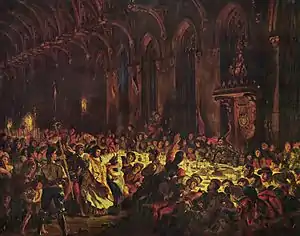The Murder of the Bishop of Liège
The Murder of the Bishop of Liège is an 1828 or 1829 oil on canvas painting by Eugène Delacroix, showing the murder of Louis de Bourbon, Bishop of Liège by William I de La Marck's men during the 15th-century Wars of Liège, as told in chapter 22 of Walter Scott's historical novel Quentin Durward.[1] First exhibited at the Paris Salon of 1831, it is now in the Louvre in Paris.

Its violent subject is typical of French Romantic painting and places it alongside the same artist's The Death of Sardanapalus and The Execution of Doge Marino Faliero, also painted in the late 1820s. He produced it at the same time as Boissy d’Anglas Leading a Riot (a chiaroscuro scene of revolutionary violence in a huge room) and The Battle of Nancy (similarly inspired by late medieval warfare).[2]
History

Delacroix spent May to August 1825 in Great Britain, becoming devoted to its literature, especially Scott and William Shakespeare. Murder was just one of several works by the painter to be inspired by Quentin Durward[3] – two sketches survive of The Ardennes Boar (ink on paper, showing William I de La Marck, 15 x 10.5 cm, c. 1827–1829, private collection, Paris[3]) and Quentin Durward and La Balafré (sketch, c.1828–1829, musée des beaux-arts de Caen).

Murder was commissioned by the Duke of Orléans, the future king Louis-Philippe, who became its owner. Its chiaroscuro setting was inspired by Westminster Hall in London and the Palais de Justice in Rouen. Delacroix' correspondence shows him to have been worried about the work, only completing it once he was sure it would be his "Austerlitz" not his Waterloo.[2] For some time it was exhibited at the gallery of Henri Gaugain, an art dealer and publisher[4] before being put on show at the 1831 Paris Salon.[5]
For Étienne-Jean Delécluze, "this little canvas yells, shouts, blasphemes ... one hears the tipsy soldiers' obscene songs. Such figures of brigands! ... What jovial and bloodthirsty bestiality! It swarms and squeaks just as it blazes and stinks!.[6] Théophile Gautier was enthusiastic about the work, stating that "for the movement and fury of its composition, it is an inimitable masterpiece, a painted whirlwind, everything moving frantically in this little space, emerging from which one seems to hear lamentations and thunder ; never have we seen thrown onto a canvas a crowd more hard, more swarming, more screaming or more enraged [...] This painting is truly tumultuous and loud ; we hear it as much as we see it.[7]}} However, classical art critics savaged the work as too innovative – "[The same artist's] The Bridge at Taillebourg was a painting by a savage, and The Murder of the Bishop of Liège is furious debauchery by a barbarian. What is he in himself? A monkey adorned with Titian's meltwater."[8]
References
- "" L'Assassinat de l'évêque de Liège ", on museeduluxembourg.fr".
- René Huyghe, Delacroix ou le combat solitaire, Hachette, 1964, p. 187-189.
- "" Eugène Delacroix ", on lanouvelleathenes.fr".
- "Linda Whiteley, « Art et commerce d'art en France avant l'époque impressionniste » in: Romantisme, 1983, no.40. L'argent. p.71".
- Gustave Planche, Salon de 1831, on gallica.bnf.fr, Paris, Pinard, 1831, p. 114-116.
- Étienne-Jean Delécluze, cited in « L'Assassinat de l'évêque de Liège », on idixa.net (accessed 25 July 2016)"
- Théophile Gautier, « Exposition du Louvre », sur theophilegautier.fr, La Presse, 22 mars 1838 (consulté le 25 juillet 2016).
- Eugène Delacroix à l'Exposition du Boulevard des Italiens, Paris, 1864, p.7.
